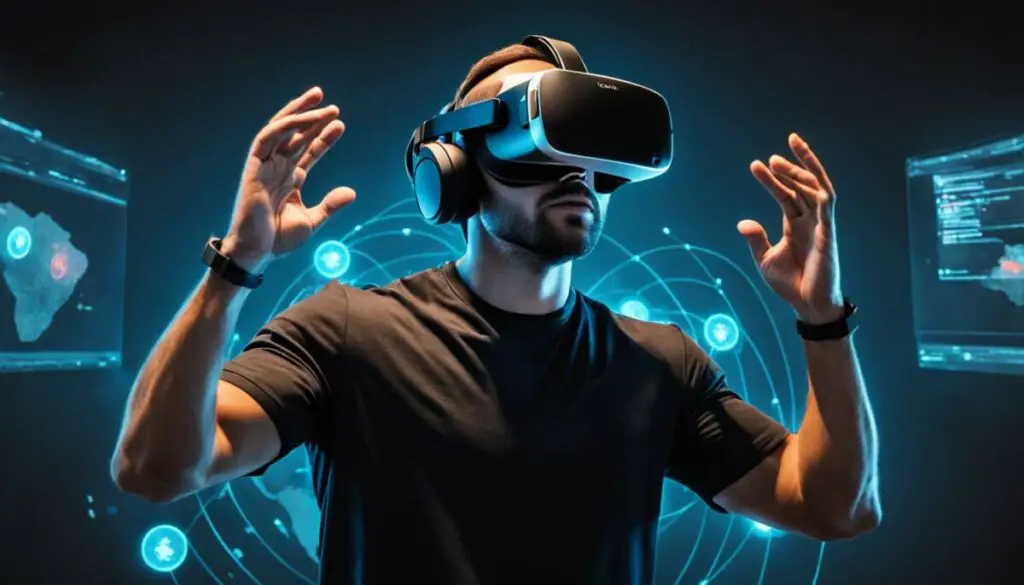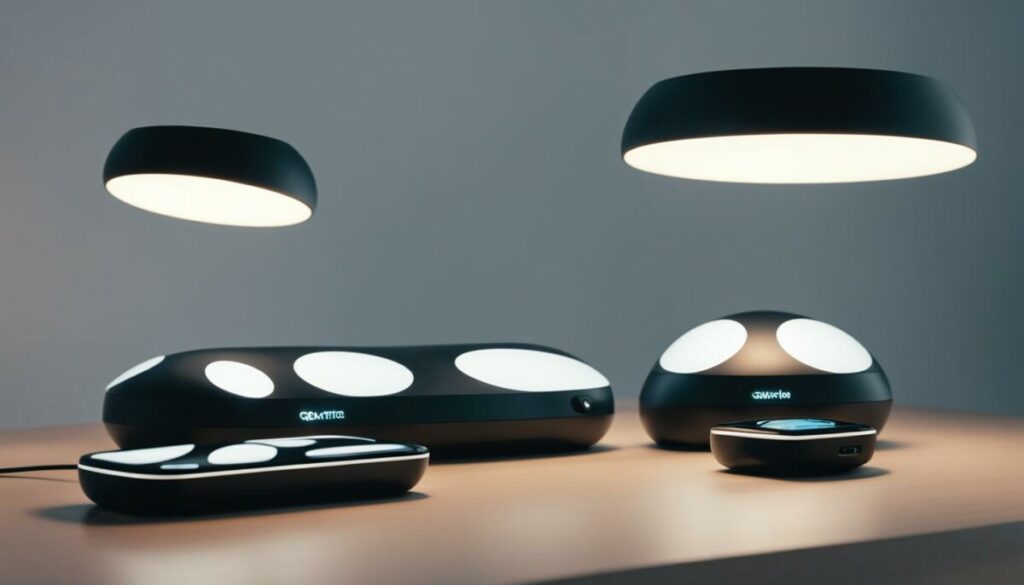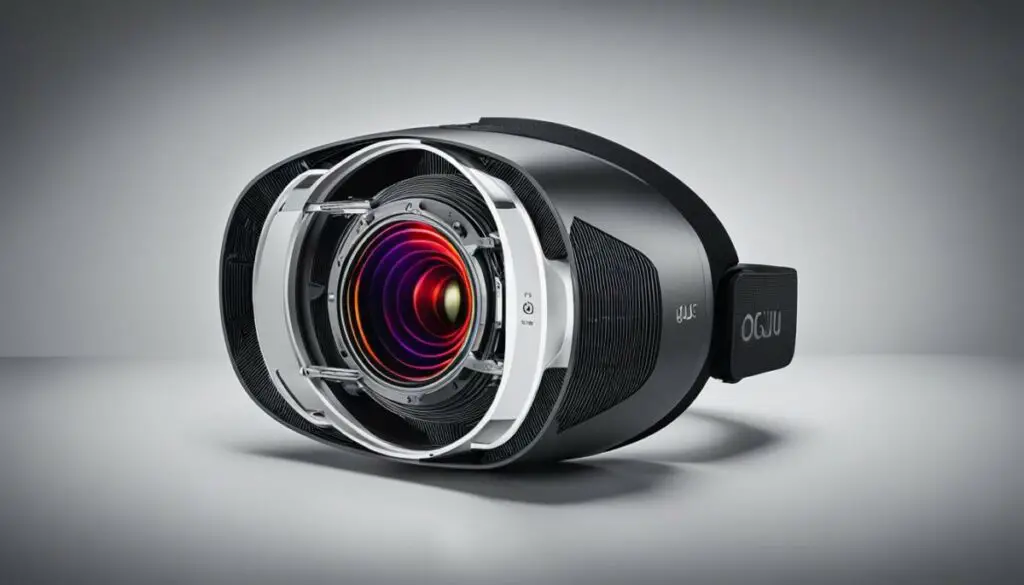Last Updated on 4 months by Francis
When it comes to virtual reality tracking, Oculus has been at the forefront of innovation. One of the key technologies that powers Oculus headsets, such as the Rift S and Quest, is Oculus Insight. But what exactly is Oculus Insight and how does it work?
Oculus Insight incorporates a combination of in-headset cameras, motion sensors, and infrared LEDs to provide precise and accurate tracking. These sensors work together to map real-world spaces into virtual reality, allowing users to navigate and interact seamlessly in the virtual realm. This revolutionary technology not only enhances the immersive experience but also opens up possibilities for the future of augmented reality.
With Facebook behind Oculus, the company has a long-term vision for Oculus Insight. They aim to push the boundaries of spatial awareness in VR and AR devices, utilizing SLAM technology with low latency and power consumption. Hand gesture recognition is also on their radar as a potential input method for virtual and augmented reality experiences.
In this article, we’ll dive deeper into the intricacies of Oculus Insight, how it works, and its potential applications in the realm of mixed reality. We’ll also explore the evolution of Oculus Touch controllers and the future of Oculus headsets. Let’s embark on this exciting journey into the world of Oculus and virtual reality.
Contents
Key Takeaways:
- Oculus Insight utilizes in-headset cameras, motion sensors, and infrared LEDs for accurate tracking in virtual reality.
- This technology allows users to seamlessly navigate and interact with virtual environments.
- Oculus Insight is a stepping stone towards the development of augmented reality devices.
- Facebook envisions a future where Oculus headsets are spatially aware and feature advanced tracking capabilities.
- Oculus Touch controllers combine infrared sensors and motion tracking for a more immersive VR experience.
How Does Oculus Insight Tracking Work?
![]()
Oculus Insight utilizes a combination of in-headset cameras, motion sensors, and infrared LEDs for precise tracking in virtual reality (VR) environments. This innovative tracking system allows users to immerse themselves in virtual worlds while seamlessly interacting with the physical environment.
The in-headset cameras play a crucial role in mapping the real-world environment into VR. By capturing the surroundings, these cameras enable the system to create a digital representation of physical spaces, enhancing the sense of presence and realism.
The motion sensors track the movement of the user, capturing every subtle motion and ensuring accurate positioning within the virtual environment. This advanced VR motion tracking technology allows for precise and responsive gameplay, enhancing the overall user experience.
Additionally, the infrared LEDs integrated into the Oculus Touch controllers serve as beacons for the cameras to track their movements. This allows users to interact with virtual objects and manipulate them with natural hand motions, further blurring the line between the virtual and physical worlds.
By combining these components, Oculus Insight creates a highly accurate and responsive VR tracking system. The integration of infrared tracking technology ensures that users’ movements are captured flawlessly, offering a truly immersive and lifelike VR experience.
For a closer look at how Oculus Insight tracking works, refer to the table below:
| Component | Function |
|---|---|
| In-headset cameras | Capture the real-world environment |
| Motion sensors | Track user movement |
| Infrared LEDs | Enable seamless interaction with virtual objects |
The Future of Oculus Insight

Facebook sees a bright future for Oculus Insight, not only as the driving force behind future headsets but also as a key technology for augmented reality (AR) devices. The company’s vision includes the creation of AR glasses that possess spatial awareness, leveraging simultaneous location and mapping (SLAM) technology to deliver accurate positioning in real-time.
By combining infrared tracking technology with low latency and power consumption, Oculus Insight aims to enhance the AR experience by seamlessly blending virtual content with the physical world. Facebook’s commitment to innovation extends beyond tracking, as the company is open to exploring hand gesture recognition as an intuitive input method for both VR and AR experiences.
“Oculus Insight is not just about virtual reality; it’s about creating immersive and intuitive environments where users can interact seamlessly with their surroundings. We believe in the limitless possibilities that this technology can unlock.”
The Evolution of Oculus Insight
Since its inception, Oculus Insight has continuously evolved, paving the way for groundbreaking advancements in VR and AR. From its inception, Oculus Insight’s cutting-edge sensor system and infrared tracking technology have revolutionized the way we perceive and interact with virtual reality.
With the introduction of Oculus Touch controllers, accurate and seamless motion tracking became an integral part of the VR experience. These controllers feature infrared sensors that enable users to interact with virtual environments and objects, providing a heightened sense of immersion.
As Oculus continues to refine its technology, we can expect further enhancements to the Oculus Insight ecosystem, delivering even more precise and responsive tracking capabilities. The future of Oculus Insight is a testament to the incredible potential of virtual reality sensor technology.
The Benefits of Oculus Insight
The Oculus Insight system brings numerous benefits to the world of VR and AR. Its infrared tracking technology allows for precise and accurate mapping of real-world spaces into virtual environments, providing users with a seamless and immersive experience.
Some of the key advantages of Oculus Insight include:
- Accurate head and hand tracking, enabling natural interaction with virtual objects and environments.
- Low latency and power consumption, ensuring an uninterrupted and comfortable user experience.
- Ease of setup and use, making VR and AR accessible to a wider audience.
- Innovative hand gesture recognition, introducing intuitive and immersive input methods.
Overall, the future of Oculus Insight holds tremendous promise for the evolution of virtual reality and augmented reality, offering users unparalleled experiences and unlocking new possibilities for interactive storytelling, gaming, and beyond.
| Benefits of Oculus Insight | Advantages |
|---|---|
| Precise and Accurate Tracking | Enables natural interaction with virtual environments |
| Low Latency | Ensures an uninterrupted and comfortable user experience |
| Power Efficient | Conserves battery life and maximizes device usage |
| Easy Setup | Makes VR and AR accessible to a wider audience |
| Innovative Input Methods | Intuitive hand gesture recognition for immersive experiences |
Oculus Insight and Mixed Reality Experiences

Oculus Insight, powered by its advanced oculus sensor system, is poised to revolutionize the world of virtual reality with its cutting-edge virtual reality sensor technology. The impressive capabilities of Oculus Insight go beyond traditional VR experiences, opening up new possibilities for mixed reality.
With Oculus Insight, users can now enjoy immersive mixed reality experiences that seamlessly blend virtual and real-world content. Imagine stepping into an arena-scale tracking demo where you can interact with both physical and virtual objects, creating truly engaging multiplayer experiences. It’s a whole new level of immersion that takes virtual reality to new heights.
Oculus, a Facebook-owned company, is constantly exploring ways to customize the Oculus Insight tracking system to cater to diverse location-based experiences. Theme parks dedicated to VR attractions, for example, can leverage the power of Oculus Insight to deliver mind-blowing adventures with unparalleled realism.
“Our goal is to create unforgettable mixed reality experiences that blur the line between what is real and what is virtual. By combining the precision of our oculus sensor system with innovative virtual reality sensor technology, we’re opening up a world of possibilities for users to explore,” said Mark Zuckerberg, CEO of Facebook.
Comparison of Oculus Insight and Traditional VR Tracking Systems
| Features | Oculus Insight | Traditional VR Tracking |
|---|---|---|
| Precision | Highly accurate, enabling precise tracking of user movement and interactions with virtual objects. | Relatively accurate, but may experience occasional tracking drift or latency. |
| Scalability | Arena-scale tracking allows for large-scale multiplayer experiences and seamless interaction with real-world objects. | Limited to smaller play areas, reducing the scope for extensive physical movement. |
| Realism | Enables realistic mixed reality experiences by integrating virtual and physical elements seamlessly. | Primarily focuses on creating immersive virtual environments with limited interaction with the real world. |
| Customization | Offers flexibility for customizing tracking for location-based experiences and theme park-like VR attractions. | Less room for customization, limiting the range of experiences that can be created. |
With the unique capabilities of Oculus Insight and the advances in virtual reality sensor technology, mixed reality experiences are becoming more captivating and accessible. The boundaries between the virtual and real world are blurring, providing users with unforgettable moments of awe and wonder.
Oculus Touch Controllers and Infrared Tracking

When it comes to enhancing the immersive virtual reality (VR) experience, the Oculus Touch controllers play a vital role. These innovative controllers utilize advanced infrared sensor technology to bring your virtual interactions to life. By incorporating infrared LEDs in their rings, the controllers enable precise tracking in three-dimensional space, unlocking a whole new level of user engagement and immersion.
The infrared tracking technology used in the Oculus Touch controllers allows for seamless interaction with virtual environments. As you move your hands and fingers, the sensors detect the position and orientation of the controllers, translating your real-world movements into the virtual realm. This enables you to manipulate objects, interact with virtual characters, and navigate through immersive VR worlds with remarkable accuracy and responsiveness.
Key Features of Oculus Touch Controllers:
- Precision Tracking: Thanks to the built-in infrared sensors, the controllers can accurately track your hand movements, ensuring seamless integration with the virtual environment.
- Gesture Recognition: The controllers feature finger gesture detection, bringing a new level of realism and immersion to VR experiences by allowing you to use natural hand gestures to interact with objects and characters.
- Ergonomic Design: Designed with comfort in mind, the controllers fit snugly in your hands, allowing for extended periods of gameplay without discomfort or fatigue.
- Intuitive Controls: The placement of buttons, triggers, and joysticks on the controllers provides intuitive and responsive control, enhancing the overall gaming experience.
With the Oculus Touch controllers and their infrared tracking capabilities, you can truly feel connected to the virtual world, making your VR experiences more immersive and engaging than ever before.
“The Oculus Touch controllers revolutionize the way we interact with virtual reality. With their infrared tracking technology and intuitive design, they offer a level of immersion that is hard to match.” – VR enthusiast
The Evolution of Oculus Touch Controllers

Oculus Touch controllers have undergone significant advancements over the years, revolutionizing the VR gaming experience. From changes in tracking systems to improvements in design and functionality, these controllers have continuously evolved to enhance accuracy and immersion.
The Switch to Inside-Out Tracking
One notable evolution in Oculus Touch controllers is the switch to inside-out tracking. This technology allows the controllers to track their position and movement without the need for external sensors. By utilizing sensors and cameras within the headset, users can enjoy a more streamlined and convenient setup.
Design Changes for Enhanced Ergonomics
The latest iteration of Oculus Touch controllers, known as Touch Pro, introduces improved ergonomics for a more comfortable and natural feel in the hands of the user. These design changes not only enhance comfort during extended gameplay sessions but also contribute to better control and precision.
Enhanced Features for Immersive Gameplay
Oculus has also integrated enhanced features into the Touch Pro controllers to enrich the VR gaming experience. One notable addition is haptic feedback, providing realistic tactile sensations to further immerse users in the virtual world. Additionally, the controllers now come with rechargeable batteries, eliminating the need for frequent battery replacements and ensuring extended gameplay sessions.
These advancements in Oculus Touch controllers contribute to a more realistic and engaging VR gaming experience. The combination of inside-out tracking, improved ergonomics, haptic feedback, and rechargeable batteries enables users to interact with virtual environments seamlessly, adding a new level of immersion to gameplay.
Rift S and the Future of Oculus Headsets

In the world of virtual reality, Oculus headsets have been at the forefront of technological advancements. The rumored release of the Rift S headset has generated a buzz among VR enthusiasts and gamers alike. This new headset is expected to build upon the success of its predecessor, the original Oculus Rift, and bring exciting improvements to the table.
One of the notable upgrades projected for the Rift S is a higher resolution display. This means users can expect a sharper and more immersive visual experience when diving into virtual worlds. Additionally, the Rift S is expected to feature inside-out tracking utilizing Oculus Insight technology. This innovative infrared tracking system, combined with the headset’s built-in cameras, will provide precise and responsive motion tracking without the need for external sensors.
Improved optics are also anticipated in the Rift S, ensuring clearer visuals and reducing eye fatigue during extended VR sessions. Facebook, the parent company of Oculus, aims to make VR headsets more accessible and user-friendly. With the Rift S, they envision a device that offers a seamless and comfortable VR experience for both hardcore gamers and casual users.
As the future of Oculus headsets unfolds, the Rift S paves the way for exciting advancements in virtual reality technology. With improved display resolution, inside-out tracking, and enhanced optics, this headset promises to take the virtual reality experience to new heights.
Rift S Expected Features:
| Feature | Description |
|---|---|
| Higher Resolution Display | Achieve sharper and more detailed visuals for an immersive VR experience |
| Inside-Out Tracking | Utilize Oculus Insight technology for precise motion tracking without external sensors |
| Improved Optics | Enhance visual clarity and decrease eye fatigue for extended VR sessions |
| User-Friendly Experience | Create a seamless and comfortable VR experience accessible to gamers and casual users alike |
The Success of Oculus Rift
Despite its age, the Oculus Rift remains one of the leading consumer VR headsets in terms of popularity and usage. The original Rift, released in 2016, has undergone price reductions and improvements, including the introduction of Touch controllers. The headset supports room-scale tracking and offers a wide range of immersive VR experiences.
The Popularity of Oculus Rift
The Oculus Rift has garnered a devoted following since its launch. VR enthusiasts and gamers have embraced the Rift for its impressive virtual reality tracking capabilities and immersive experiences. The combination of the oculus sensor system and infrared sensor technology in the headset allows for accurate and responsive motion tracking, enhancing the sense of presence in virtual environments.
“The Oculus Rift revolutionized the gaming industry by bringing virtual reality into the mainstream. Its advanced tracking technology and immersive experiences have made it a go-to choice for VR enthusiasts.” – [Source Name]
Oculus Rift and the Evolution of VR
The success of the Oculus Rift has played a significant role in the advancement of virtual reality technology. The headset has paved the way for the development of more accessible and user-friendly VR devices. Its room-scale tracking capabilities have allowed users to freely explore virtual worlds and interact with virtual objects, creating a truly immersive experience.
The introduction of Touch controllers further enhanced the Oculus Rift’s appeal. These controllers, tracked by the infrared sensor technology, offer precise and intuitive hand tracking, allowing users to interact with virtual environments in a more natural and immersive way.
Comparison of Oculus Rift and Competitors
| Headset | Tracking Technology | Supported Experiences |
|---|---|---|
| Oculus Rift | Infrared Sensor Technology | Room-scale tracking, immersive VR experiences |
| HTC Vive | Lighthouse Tracking System | Room-scale tracking, room-scale VR experiences |
| PlayStation VR | PlayStation Camera | Seated and room-scale tracking, console VR experiences |
The Oculus Rift has established itself as a frontrunner in the VR industry, competing with other leading VR headsets such as the HTC Vive and PlayStation VR. Its advanced tracking technology, in combination with a wide range of supported experiences, sets it apart from its competitors.
As virtual reality continues to evolve, the success of the Oculus Rift serves as a testament to the growing popularity and potential of VR technology. With ongoing advancements in the oculus sensor system and virtual reality tracking, the future of VR looks promising as it continues to redefine gaming, entertainment, and various industries.
Conclusion
The utilization of infrared sensor technology in Oculus Insight has brought a significant revolution to the virtual reality industry. With its accurate and seamless motion tracking capabilities, it has transformed the way people can fully immerse themselves in virtual worlds. As a result, this technology serves as the foundation for future Oculus headsets, making virtual reality more accessible and user-friendly for enthusiasts and gamers alike.
Furthermore, Oculus Insight’s infrared sensors enable virtual reality tracking that maps real-world spaces into immersive experiences. This opens the door to a wide range of possibilities, including mixed reality experiences that combine virtual and real-world content. Imagine stepping into a virtual arena where you can interact with both physical and virtual objects, creating truly immersive and captivating multiplayer experiences.
Looking ahead, the future of virtual reality and augmented reality appears promising with the continued advancements in Oculus Touch controllers and the potential for even more incredible mixed reality experiences. With ongoing innovation and the integration of infrared sensor technology, Oculus is driving the evolution of VR and AR technology, ensuring that users can truly feel present in virtual environments.
FAQ
Are Oculus Sensors Infrared?
Yes, Oculus sensors utilize infrared technology for tracking in virtual reality experiences. The combination of in-headset cameras, motion sensors, and infrared LEDs allows for accurate and seamless motion tracking.
How Does Oculus Insight Tracking Work?
Oculus Insight tracking combines in-headset cameras, motion sensors, and infrared LEDs. The cameras capture the real-world environment, enabling the system to map physical spaces into virtual reality. The motion sensors track the movement of the user, while the infrared LEDs in the controllers are tracked by the cameras, allowing virtual objects to interact smoothly with the physical world.
What is the Future of Oculus Insight?
Facebook envisions Oculus Insight as the technology that will drive future headsets, including augmented reality devices. The company aims to create AR glasses that combine virtual worlds with real-world objects, utilizing SLAM technology for spatial awareness with low latency and power consumption. Facebook is also exploring hand gesture recognition as a form of input for VR and AR experiences.
What Are Mixed Reality Experiences with Oculus Insight?
Oculus Insight has the potential to enable mixed reality experiences by seamlessly blending virtual and real-world content. Examples include arena-scale tracking demos where players interact with both real and virtual objects, creating immersive multiplayer experiences. Facebook is also exploring customization of Oculus Insight tracking for location-based experiences in theme park-like VR attractions.
How Does Infrared Tracking Work with Oculus Touch Controllers?
Oculus Touch controllers contain infrared LEDs in their rings, allowing them to be tracked in 3D space by the sensors. The controllers use infrared tracking technology to interact with virtual environments and provide a seamless user experience. Additionally, the controllers feature finger gesture detection, enhancing the level of immersion in VR experiences.
What is the Evolution of Oculus Touch Controllers?
Oculus Touch controllers have undergone revisions over the years, including a switch to inside-out tracking and design changes. The latest iteration, known as Touch Pro, features on-board tracking systems, improved ergonomics, haptic feedback, and rechargeable batteries. These advancements improve accuracy and performance, enhancing the overall VR gaming experience.
What Can We Expect from Rift S and the Future of Oculus Headsets?
The rumored Rift S headset is expected to be a refresh of the original Oculus Rift. It is speculated to feature a higher resolution display, inside-out tracking using Oculus Insight technology, and improved optics. The Rift S is part of Facebook’s vision to make VR headsets more accessible and user-friendly, paving the way for future advancements in virtual reality technology.
What Makes Oculus Rift a Successful Consumer VR Headset?
Despite its age, the Oculus Rift remains one of the leading consumer VR headsets in terms of popularity and usage. The original Rift, released in 2016, has undergone price reductions and improvements, including the introduction of Touch controllers. The headset supports room-scale tracking and offers a wide range of immersive VR experiences.
What is the Conclusion for Oculus Sensors and Tracking?
Oculus Insight’s use of infrared tracking technology has revolutionized the VR industry by providing accurate and seamless motion tracking. This technology serves as the foundation for future Oculus headsets and is a stepping stone towards augmented reality devices. With advancements in Oculus Touch controllers and the potential for mixed reality experiences, the future of VR and AR looks promising.








